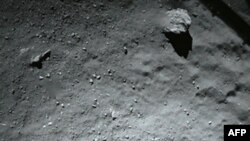The comet lander Philae may be uncommunicative at the moment, but the pictures and measurements it took after it touched down on a comet in November have shown scientists that the comet is covered with coarse material, rather than dust, and is harder than expected.
European scientists celebrated a historic first when Philae landed on a comet called 67P/Churyumov-Gerasimenko in November after a 10-year journey through space aboard the Rosetta spacecraft.
As it landed, Philae bounced and ended up in shadow, where its batteries soon ran out. But it still gathered unprecedented data, some of which the DLR German Aerospace Center said "amazed" scientists. A report on its findings will be published Friday in a special edition of the journal Science.
"The experiments conducted on-site have led to new and, at times, unexpected insights into the nature of the comet," Ekkehard Kuehrt, a planetary researcher at the DLR, said in a statement Thursday.
For example, pictures taken by Philae as it came in to land showed the surface of the comet was covered with coarse debris, rocks and pebbles, measuring up to 5 meters (more than 16 feet) across, rather than the dusty deposits expected.
Scientists suspect the surface is partly shaped by a form of hail that occurs when gas ejections from the comet push out coarse particles that then fall back to the ground.
The surface of the comet, which the lander tried to drill into, also proved to be much harder than expected. Under a few centimeters of dust, the lander's hammer encountered solid ice.
"This ice is similar to firn on Earth, which is old, solid snow that evaporates and refreezes," said Tilman Spohn, planetary researcher at DLR.
Scientists hope samples drilled by Philae from the roughly 3-by-5-kilometer (1.9-by-3.1-mile) comet will unlock details about how the planets — and possibly even life — evolved. The rock and ice that make up comets preserve ancient organic molecules like a time capsule.
According to the DLR, Philae's systems found a total of 16 organic molecular species, including four never before encountered in comets.
Philae woke up last month when more sunlight started falling on its solar panels as the comet approached the sun, but scientists have been unable to establish a reliable communication link.
With an eye to possible future comet missions, Stephan Ulamec from the DLR said one important lesson had been learned: "Bouncing is a bigger problem than a possible sinking into the ground."









